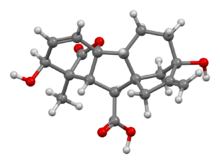Chemistry:Gibberellic acid

| |

| |
| Names | |
|---|---|
| IUPAC name
(3S,3aS,4S,4aS,7S,9aR,9bR,12S)-7,12-Dihydroxy-3-methyl-6-methylene-2-oxoperhydro-4a,7-methano-9b,3-propenoazuleno[1,2-b]furan-4-carboxylic acid
| |
| Identifiers | |
3D model (JSmol)
|
|
| 54346 | |
| ChEBI | |
| ChEMBL | |
| ChemSpider | |
| DrugBank | |
| EC Number |
|
| KEGG | |
PubChem CID
|
|
| UNII | |
| |
| |
| Properties | |
| C19H22O6 | |
| Molar mass | 346.379 g·mol−1 |
| Melting point | 233 to 235 °C (451 to 455 °F; 506 to 508 K) (decomposition) |
| 5 g/L (20 °C) | |
| Hazards | |
| GHS pictograms | 
|
| GHS Signal word | Warning |
| H319 | |
| P264, P280, P305+351+338, P337+313 | |
Except where otherwise noted, data are given for materials in their standard state (at 25 °C [77 °F], 100 kPa). | |
| Infobox references | |
Gibberellic acid (also called gibberellin A3 or GA3) is a hormone found in plants and fungi.[1] Its chemical formula is C19H22O6. When purified, it is a white to pale-yellow solid.
Plants in their normal state produce large amounts of GA3. It is possible to produce the hormone industrially using microorganisms.[2] Gibberellic acid is a simple gibberellin, a pentacyclic diterpene acid promoting growth and elongation of cells. It affects decomposition of plants and helps plants grow if used in small amounts, but eventually plants develop tolerance to it.[citation needed] GA stimulates the cells of germinating seeds to produce mRNA molecules that code for hydrolytic enzymes. Gibberellic acid is a very potent hormone whose natural occurrence in plants controls their development. Since GA regulates growth, applications of very low concentrations can have a profound effect while too much will have the opposite effect.[3] It is usually used in concentrations between 0.01 and 10 mg/L.[citation needed]
GA was first identified in Japan in 1926, as a metabolic by-product of the plant pathogen Gibberella fujikuroi (thus the name), which afflicts rice plants. Fujikuroi-infected plants develop bakanae ("foolish seedling"), which causes them to rapidly elongate beyond their normal adult height. The plants subsequently lodge due to lack of support, and die.[2]
Gibberellins have a number of effects on plant development. They can stimulate rapid stem and root growth, induce mitotic division in the leaves of some plants, and increase seed germination rates.[4]
Gibberellic acid is sometimes used in laboratory and greenhouse settings to trigger germination in seeds that would otherwise remain dormant.[3] It is also widely used in the grape-growing industry as a hormone to induce the production of larger bunches and bigger grapes, especially Thompson seedless grapes. In the Okanagan and Creston valleys, it is also used as a growth regulator in the cherry industry. It is used on Clementine Mandarin oranges, which may otherwise cross-pollinate with other citrus and produce undesirable seeds. Applied directly on the blossoms as a spray, it allows for Clementines to produce a full crop of seedless fruit.
GA is widely used in the barley malting industry. A GA solution is sprayed on the barley after the steeping process is completed. This stimulates growth in otherwise partly dormant kernels and produces a uniform and rapid growth.
See also
References
- ↑ "Gibberellic acid fermented extract obtained by solid-state fermentation using citric pulp by Fusarium moniliforme: Influence on Lavandula angustifolia Mill. cultivated in vitro". Pakistan Journal of Botany 45 (6): 2057–2064. 2013. http://www.pakbs.org/pjbot/PDFs/45(6)/30.pdf. Retrieved 26 November 2014.
- ↑ 2.0 2.1 Camara, M. C. et al (2015) General Aspects and Applications of Gibberelins and Gibberellic Acid in Plants. In: Hardy, J.. (Org.). Gibberellins and Gibberellic Acid: Biosynthesis, Regulation and Physiological Effects. 1ed.Hauppauge: Nova Science Publishers, 2015, v., p. 1-21.
- ↑ 3.0 3.1 Riley, John M.. "Gibberellic Acid for Fruit Set and Seed Germination". http://www.crfg.org/tidbits/gibberellic.html.
- ↑ Edwards, Miriam (1976). "Dormancy in Seeds of Charlock (Sinapis arvensis L.)". Plant Physiol. 58 (5): 626–630. doi:10.1104/pp.58.5.626. PMID 16659732.
 |

